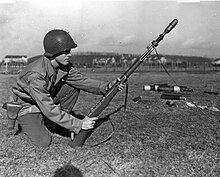M7 (grenade launcher)
The M7 grenade launcher was a grenade launcher for the M1 Garand rifle and 22 mm rifle grenades. It was used in World War II and the Korean War .
The grenade launcher was attached to the barrel and a rifle grenade was attached. The gases produced when a special blank cartridge was fired then hurled the grenade up to 350 meters.
There were HE shells, armor piercing and smoke grenades for the M7.
development
When the United States entered World War II in 1941, all units were equipped with the Mk 2 hand grenade . As a hand grenade, it could naturally only be thrown about 30 meters and was ineffective against armored targets. In order to keep its weight low, a small charge had to be used, so that the radius in which the grenade was deadly was only around five and a half meters.
Farther away targets could be fired at with the Springfield M1903 and M1917 Enfield rifle grenade attachments , but both types of rifles were to be retired by 1943. In order to be able to continue firing rifle grenades, the United States Army Ordnance Department (comparable to the Heereswaffenamt or Office for Defense Technology and Procurement) developed a new grenade launcher for the M1 Garand rifle, which was designated as M7. The HE shells fired from it had a deadly radius of 10 meters. Production and use began in 1943.
There were also further developed models, for example the M7A1 (Springfield Armory T95), manufactured from July 1945 to 1951.
Details
The M7 grenade launcher is tubular. One end fits onto the barrel, encloses the muzzle and is attached to the bayonet mount. The other end is hollow and has a small bracket that holds a grenade attached by friction.
In order to fire a grenade, a more powerful blank cartridge specially developed for this purpose was inserted into the rifle and a grenade attached. The desired firing range could be varied by attaching the grenade to different distances on the launcher, which was equipped with recessed markings. Due to the considerably increased recoil in comparison to the normal cartridge, the rifle grenade could not be fired normally, i.e. with the butt at the shoulder. Firing the butt at the shoulder would have broken the soldier's collarbone. Therefore, the butt was propped on the ground (see photo) and the grenade was shot indirectly at the enemy, similar to a mortar . This form of shooting made it possible on the one hand to fight targets in trenches, for example , since the grenade was fired in a high arc at its target; on the other hand, direct fire, for example into the window of a building, was impossible.
Due to the complex preparation (put on grenade, remove magazine, load special cartridge, determine (firing) angle) the soldiers were slowed down, which can be fatal, especially in combat. On the other hand, the common soldier was practically provided with his own mortar with which he could destroy armored vehicles and shoot them in trenches; ideally without having to expose yourself to enemy fire.
The firing range depended not only on the depth of attachment but also on the mass of the grenade and the angle of fire.
Since the grenade launcher prevented the semi-automatic mode of the rifle in order to avoid damage to the rifle when the grenade was fired, it could not be fired normally while the M7 was mounted. If necessary it could be used as a repeating rifle .
Hand grenades could also be fired using an adapter. Three M7 grenade launchers were assigned to each rifle squad .
Individual evidence
- ^ A b c Michael Green: Weapons of Patton's Armies . Zenith Imprint, 2000, ISBN 0760308217 , pp. 35-36.
- ↑ Michael Green, Stewart, Greg: Weapons of the Modern Marines . Zenith Imprint, 2004, ISBN 076031697X , pp. 25-26.
- ↑ John Sayen, Anderson, Duncan: US Army Infantry Divisions 1944-45 . Osprey Publishing , 2007, ISBN 1846031192 , p. 10.
